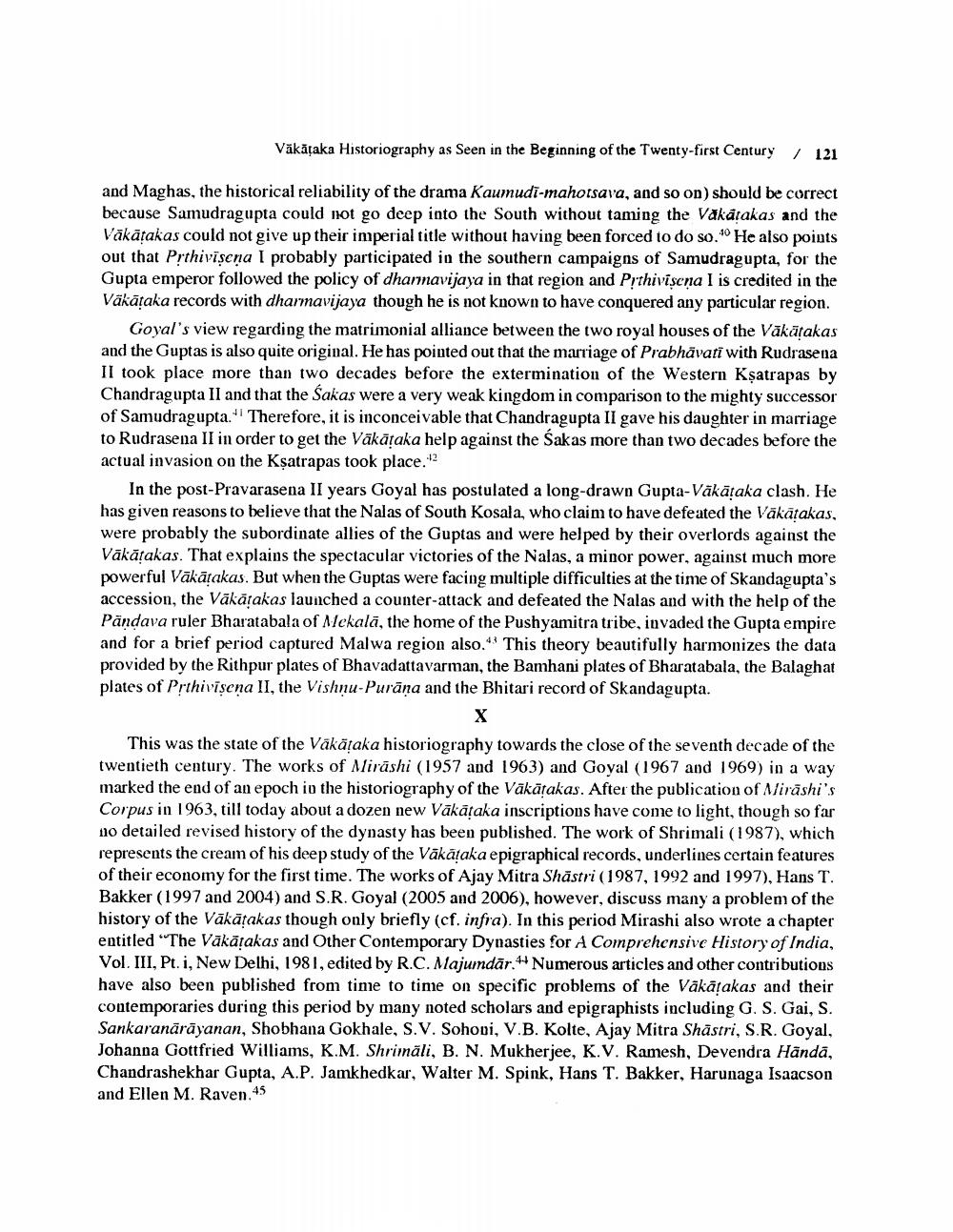________________
Väkäraka Historiography as Seen in the Beginning of the Twenty-first Century
/
121
and Maghas, the historical reliability of the drama Kaumudi-mahotsava, and so on) should be correct because Samudragupta could not go deep into the South without taming the Vakatakas and the Vākātakas could not give up their imperial title without having been forced to do so." He also points out that Prthivīșeņa I probably participated in the southern campaigns of Samudragupta, for the Gupta emperor followed the policy of dharmavijaya in that region and Prthivisena I is credited in the Väkātaka records with dharmavijaya though he is not known to have conquered any particular region.
Goyal's view regarding the matrimonial alliance between the two royal houses of the Vākātakas and the Guptas is also quite original. He has pointed out that the marriage of Prabhāvati with Rudrasena II took place more than two decades before the extermination of the Western Kșatrapas by Chandragupta II and that the Sakas were a very weak kingdom in comparison to the mighty successor of Samudragupta." Therefore, it is inconceivable that Chandragupta II gave his daughter in marriage to Rudrasena II in order to get the Vākātaka help against the Sakas more than two decades before the actual invasion on the Ksatrapas took place."
In the post-Pravarasena II years Goyal has postulated a long-drawn Gupta-Vākātaka clash. He has given reasons to believe that the Nalas of South Kosala, who claim to have defeated the Väkātakas, were probably the subordinate allies of the Guptas and were helped by their overlords against the Vākāțakas. That explains the spectacular victories of the Nalas, a minor power, against much more powerful Vākārakas. But when the Guptas were facing multiple difficulties at the time of Skandagupta's accession, the Vākāļakas launched a counter-attack and defeated the Nalas and with the help of the Pändava ruler Bharatabala of Mekalā, the home of the Pushyamitra tribe, invaded the Gupta empire and for a brief period captured Malwa region also. This theory beautifully harmonizes the data provided by the Rithpur plates of Bhavadattavarman, the Bamhani plates of Bharatabala, the Balaghat plates of Prthivişena II, the Vishnu-Purāna and the Bhitari record of Skandagupta.
This was the state of the Vākāraka historiography towards the close of the seventh decade of the twentieth century. The works of Mirāshi (1957 and 1963) and Goyal (1967 and 1969) in a way marked the end of an epoch in the historiography of the Vākātakas. After the publication of Mirashi's Corpus in 1963, till today about a dozen new Vākātaka inscriptions have come to light, though so far 110 detailed revised history of the dynasty has been published. The work of Shrimali (1987), which represents the cream of his deep study of the Vākātaka epigraphical records, underlines certain features of their economy for the first time. The works of Ajay Mitra Shāstri (1987, 1992 and 1997), Hans T. Bakker (1997 and 2004) and S.R. Goyal (2005 and 2006), however, discuss many a problem of the history of the Vākāțakas though only briefly (cf. infra). In this period Mirashi also wrote a chapter entitled "The Vākāļakas and Other Contemporary Dynasties for A Comprehensive History of India, Vol. III, Pt. i, New Delhi, 1981, edited by R.C. Majumdar. # Numerous articles and other contributions have also been published from time to time on specific problems of the Vākāțakas and their contemporaries during this period by many noted scholars and epigraphists including G. S. Gai, S. Sankaranārāyanan, Shobhana Gokhale, S.V. Sohovi, V.B. Kolte, Ajay Mitra Shāstri, S.R. Goyal, Johanna Gottfried Williams, K.M. Shrimāli, B. N. Mukherjee, K.V. Ramesh, Devendra Hānda, Chandrashekhar Gupta, A.P. Jamkhedkar, Walter M. Spink, Hans T. Bakker, Harunaga Isaacson and Ellen M. Raven.45




